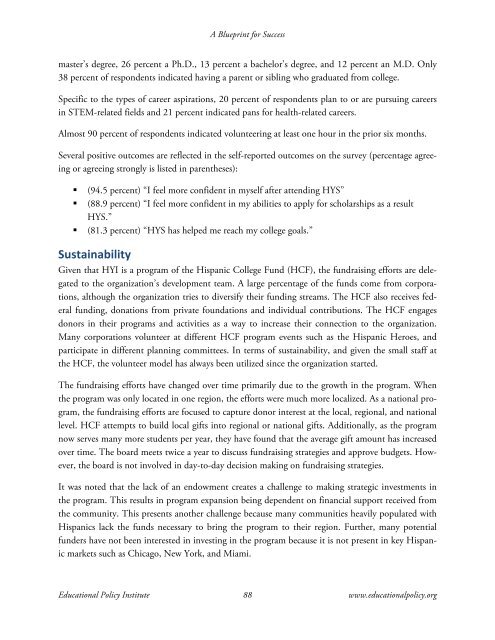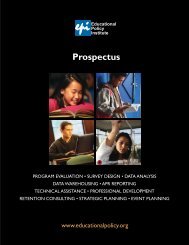A BluePrint for Success: Case Studies of Successful - Educational ...
A BluePrint for Success: Case Studies of Successful - Educational ...
A BluePrint for Success: Case Studies of Successful - Educational ...
You also want an ePaper? Increase the reach of your titles
YUMPU automatically turns print PDFs into web optimized ePapers that Google loves.
A Blueprint <strong>for</strong> <strong>Success</strong><br />
master’s degree, 26 percent a Ph.D., 13 percent a bachelor’s degree, and 12 percent an M.D. Only<br />
38 percent <strong>of</strong> respondents indicated having a parent or sibling who graduated from college.<br />
Specific to the types <strong>of</strong> career aspirations, 20 percent <strong>of</strong> respondents plan to or are pursuing careers<br />
in STEM-related fields and 21 percent indicated pans <strong>for</strong> health-related careers.<br />
Almost 90 percent <strong>of</strong> respondents indicated volunteering at least one hour in the prior six months.<br />
Several positive outcomes are reflected in the self-reported outcomes on the survey (percentage agreeing<br />
or agreeing strongly is listed in parentheses):<br />
(94.5 percent) “I feel more confident in myself after attending HYS”<br />
(88.9 percent) “I feel more confident in my abilities to apply <strong>for</strong> scholarships as a result<br />
HYS.”<br />
(81.3 percent) “HYS has helped me reach my college goals.”<br />
Sustainability<br />
Given that HYI is a program <strong>of</strong> the Hispanic College Fund (HCF), the fundraising ef<strong>for</strong>ts are delegated<br />
to the organization’s development team. A large percentage <strong>of</strong> the funds come from corporations,<br />
although the organization tries to diversify their funding streams. The HCF also receives federal<br />
funding, donations from private foundations and individual contributions. The HCF engages<br />
donors in their programs and activities as a way to increase their connection to the organization.<br />
Many corporations volunteer at different HCF program events such as the Hispanic Heroes, and<br />
participate in different planning committees. In terms <strong>of</strong> sustainability, and given the small staff at<br />
the HCF, the volunteer model has always been utilized since the organization started.<br />
The fundraising ef<strong>for</strong>ts have changed over time primarily due to the growth in the program. When<br />
the program was only located in one region, the ef<strong>for</strong>ts were much more localized. As a national program,<br />
the fundraising ef<strong>for</strong>ts are focused to capture donor interest at the local, regional, and national<br />
level. HCF attempts to build local gifts into regional or national gifts. Additionally, as the program<br />
now serves many more students per year, they have found that the average gift amount has increased<br />
over time. The board meets twice a year to discuss fundraising strategies and approve budgets. However,<br />
the board is not involved in day-to-day decision making on fundraising strategies.<br />
It was noted that the lack <strong>of</strong> an endowment creates a challenge to making strategic investments in<br />
the program. This results in program expansion being dependent on financial support received from<br />
the community. This presents another challenge because many communities heavily populated with<br />
Hispanics lack the funds necessary to bring the program to their region. Further, many potential<br />
funders have not been interested in investing in the program because it is not present in key Hispanic<br />
markets such as Chicago, New York, and Miami.<br />
<strong>Educational</strong> Policy Institute 88 www.educationalpolicy.org




